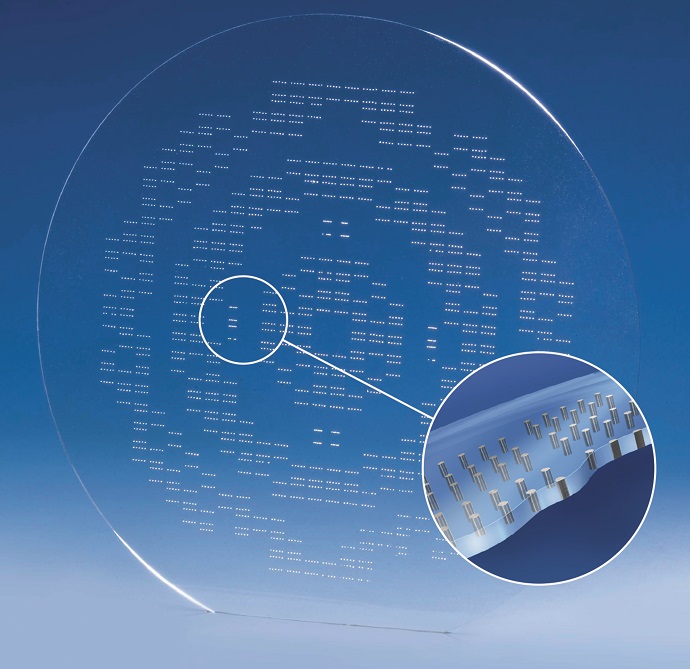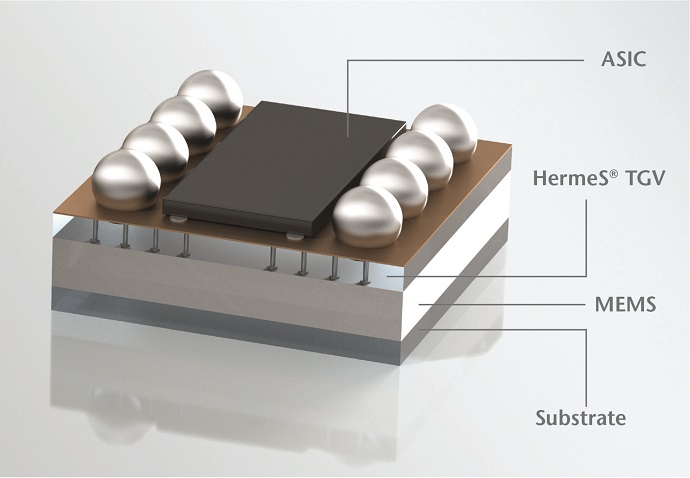Nov. 19, 2014
The international technology group SCHOTT is expanding its HermeS® wafers with hermetically sealed, solid through glass vias (TGV) into MEMS applications. HermeS glass substrates are fully gastight, and therefore enable long-term, robust enclosures for MEMS devices. The fine-pitched vias reliably conduct electrical signals and guide power into and out of the MEMS device. Since HermeS glass can be placed directly under the silicon MEMS, it makes miniaturized, fully hermetic 3-D wafer-level chip-size packaging (WLCSP) possible. Thanks to its extremely high reliability, HermeS wafers provide advantages for MEMS devices used in industrial, medical, and radio-frequency (RF) applications.
MEMS-powered devices and sensors must function perfectly over long periods of time, even when they are exposed to extremely harsh environments, such as pressure sensors in corrosive industrial production lines. The reliability and performance of the MEMS device depends on the long-term robustness of the MEMS packaging technology. SCHOTT’s HermeS solution with TGV offers several customer advantages over other technologies, such as through silicon vias or hermetic ceramic packaging, due to glass’ superior material characteristics compared to silicon or ceramics.
First, due to the higher mechanical, thermal, and chemical resistance of glass, the packaging is especially reliable, leading to long-term performance of the MEMS device. Second, thanks to the low dielectric constant of glass and the ability to use highly conductive via materials, HermeS wafer packaging also offers excellent RF performance. Finally, the optical transparency of the glass wafer enables better processing and quality control during the production process of a MEMS device.
“Based on the key features of our material, SCHOTT identified three major applications in which the HermeS TGV substrates offer significant advantages over competitive solutions,” said Yutaka Onezawa, Sales Manager for HermeS at SCHOTT Electronic Packaging. When used in industrial hermetic MEMS sensors, HermeS glass wafers enable long-term, reliable, and extremely rugged packaging of industrial sensors. Equipped with SCHOTT’s product, medical electronics can be packaged robustly to withstand body fluids and sterilization cycles over long periods of time. For RF MEMS, HermeS wafers provide superior RF properties through absolute hermeticity in an extremely miniaturized design.

SCHOTT HermeS® Glass Wafers with Through Glass Vias
HermeS® wafers with hermetically sealed solid “Through Glass Vias” (TGV): HermeS® glass substrates enable fully gastight and therefore long-term robust enclosures for MEMS devices. The fine pitched vias allow the reliable conduction of electrical signals and power into and out of the MEMS device. Since HermeS® glass can be placed directly under the silicon MEMS, it makes miniaturized, fully hermetic 3D Wafer Level Chip Size Packaging (WLCSP) possible.
Photo: SCHOTT.
SCHOTT’s HermeS TGV substrates also allow for the miniaturization of MEMS-powered devices, a reduction in package die size, and a more compact design. The footprint can be reduced by up to 80 percent compared to conventional ceramic packaging.
“We are also able to apply state-of-the-art, wafer-scale bonding, such as anodic bonding with silicon, glass frit, and solder. Thanks to our vast competencies, our customers can rely on a complete packaged solution with a total cost-of-ownership advantage regarding yield and process reduction,” added Onezawa.
SCHOTT offers HermeS TGV substrates made from three proprietary glass types: BOROFLOAT® 33 floated borosilicate glass, AF32® eco alkali-free flat glass, and D263®T eco borosilicate glass. HermeS TGV substrates are one example of how SCHOTT’s 130 years of expertise in special-purpose glass and 70 years of experience in electronic packaging help guide the development and production of the company’s new products.
For more information: http://www.us.schott.com/epackaging/english/auto/others/hermes.html













